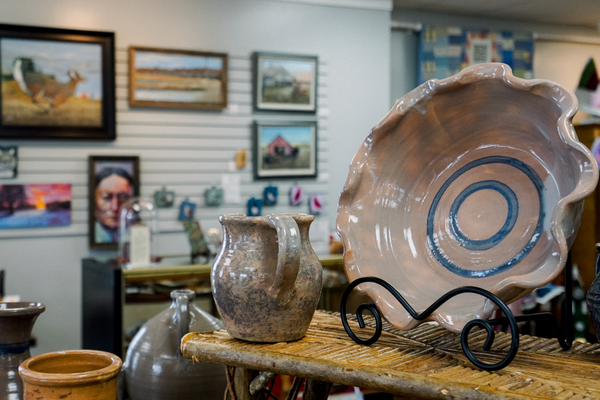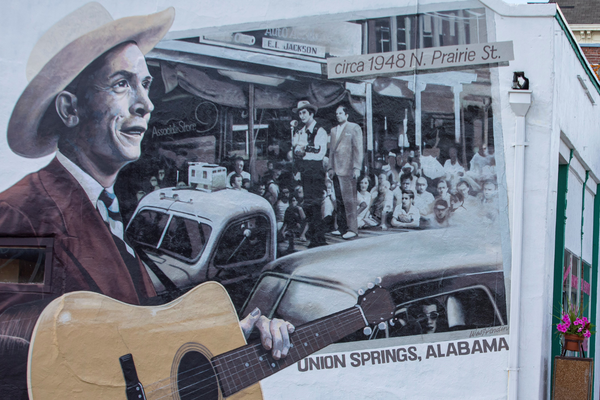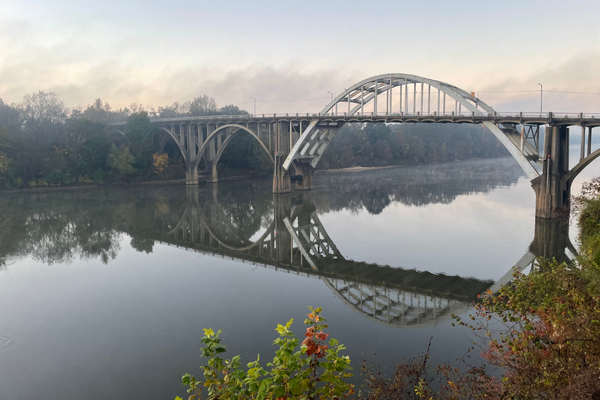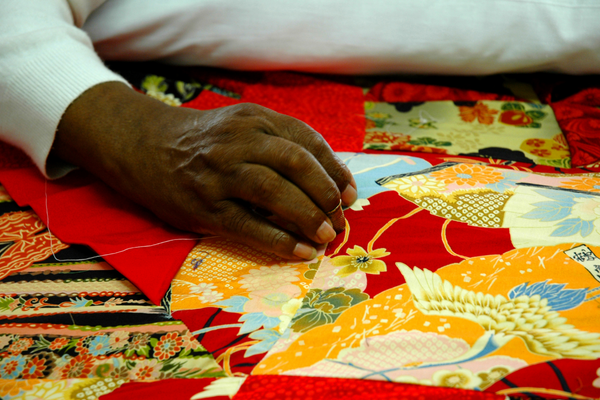Immerse Yourself in Our Black Belt Culture and Meet Our Creative People
The Black Belt culture, colorful history, and the creative people who live here, then and now, are as rich as the dark soil that covers our landscape. From the beginnings of the civil rights movement to the country crooners, to literary giants, and our multi-talented artists (both visually and performing), you’ll soon know why we cherish our home and are eager to share it with you.
Alabama Black Belt History & Heritage
Civil Rights
The Black Belt region played a critical role in the civil rights movement of the 1950s and ’60s. Visitors can walk where history was made across the region and learn from those who experienced it first-hand. Begin your journey in Selma with a guided walk across the Edmund Pettus Bridge, now a National Historic Landmark, which was the site of the brutal beatings, known as Bloody Sunday, of civil rights marchers fighting for voting rights. This event was a pivotal point in African-Americans’ quest for equal justice and the right to cast their votes.
Also in Selma, the Brown Chapel AME Church is the oldest in the South and was the starting point for the Selma-to-Montgomery march. The National Voting Rights Museum and Institute is in Selma at the foot of the Edmund Pettus Bridge and is home to artifacts and materials relating to the struggle for voting rights.
Dr. King found refuge from the Ku Klux Klan on the night of March 21, 1968, in a home in Greensboro. That small home is now The Safe House Black History Museum. In Montgomery, be sure to visit the Dexter Avenue King Memorial Baptist Church, where Dr. King was pastor, and the Rosa Parks Library and Museum, which depicts the events that led to the Montgomery Bus Boycott and early stages of the Civil Rights movement. Also in Montgomery, The Legacy Museum and The National Memorial for Peace and Justice is a national memorial to commemorate the black victims of lynching in the United States. It is intended to focus on and acknowledge past racial terrorism and advocate for social justice in America.
The Tuskegee Human and Civil Rights Multicultural Center offer insights into the contributions of three groups that shaped Tuskegee’s history – Native Americans, European-Americans, and African-Americans.
Antebellum
Visitors to Alabama’s Black Belt region can take a step back in time by visiting antebellum homes like Gaineswood in Demopolis. Gaineswood is one of America’s finest Greek Revival houses, built from 1843-1861. The house museum contains many original furnishings and objects that belonged to the original builder and owner, Gen. Nathan Bryan Whitfield. The grounds feature a gazebo, a slave house, and a small building that was probably a detached kitchen.
In Tuscaloosa, one of several antebellum homes still in use is the Jemison-Van de Graaff Mansion, built in 1859-62. The Italianate home, built by Sen. Robert Jemison Jr. to serve as his townhouse, was the first home in Tuscaloosa to have a fully plumbed bathroom, and it also had a gas plant to provide fuel for lighting.
The City of Eufaula’s main street, Eufaula Avenue, lined with dogwood, magnolias, and oaks, is flanked by antebellum mansions that host Alabama’s oldest tour of homes and has more than 700 structures listed on the National Register. Each spring, the city of Eufaula opens its doors to share this historical wealth. Visitors can take guided tours of homes and sites and enjoy an art show, concerts, a wax museum, and much more.
Old Cahawba
Alabama’s first – of five, including the territorial capital in St. Stephens – state capital sites is Old Cahawba. Cahawba was a thriving antebellum community at the confluence of the Cahaba and Alabama rivers during its time as the state capital from 1819 to 1826. Still, it became a ghost town shortly after the Civil War. Today, visitors can stroll through the Old Cahawba Archaeological Park from 9 a.m. until 5 p.m. daily and stop by the Visitors Center from noon until 5 p.m. Spend some time among the ruins and get a feel for early Alabama Black Belt culture and history.
Native American
Alabama’s most well-known Native American historical site is the Moundville Archaeological Park, about 15 miles from Tuscaloosa. Every fall, the park comes alive during the Native American Festival. Descendants from the ancient people come to perform, display arts and crafts and educate visitors of all ages on Black Belt culture. The University of Alabama’s Moundville Archaeological Park is one of the nation’s premier Native American heritage sites. Called “The Big Apple of the 14th Century” by National Geographic, Moundville Archaeological Park was once the site of a powerful prehistoric community that, at its peak, was America’s largest city north of Mexico.
Located on the Black Warrior River 13 miles south of Tuscaloosa, the park preserves 326 acres where, 800 years ago, Mississippian people constructed 29 massive flat-topped earthen mounds, arranged carefully around a vast central plaza. The mounds served as elevated platforms for civic and ceremonial structures and the homes of nobles.
Today, the panoramic landscape provides stunning views of these ancient monuments while the park’s museum displays many of the beautiful treasures unearthed at the site, including the famous stone Rattlesnake Disk. The park also features a half-mile nature trail, picnic areas, scenic views of the Black Warrior River, and a campground.
Alabama Black Belt Music & Literature
Hank Williams, Sr.
American musical hero Hank Williams, Sr. looms large in the Black Belt, from his boyhood home and museum in Georgiana to one of the world’s largest collections of Williams memorabilia in the Hank Williams Museum in Montgomery. At both, fans can experience the legend and relive his immeasurable contributions to country music.
Festivals Featuring Music
The Black Belt is also home to numerous festivals that feature all kinds of music, from the Sucarnochee Folklife Festival in Livingston to Auburn’s CityFest to the nationally renowned Kentuck Festival of the Arts in Northport.
Alabama Shakespeare Festival
Montgomery’s Alabama Shakespeare Festival produces multiple shows each year, including William Shakespeare’s “As You Like It” and “King Lear;” “The Love Songs,” featuring Elvis and Buddy Holly tribute artists; and Disney’s “The Little Mermaid.”
Harper Lee
Monroeville’s Harper Lee wrote the internationally acclaimed book, To Kill a Mockingbird. It was believed to be the only book she wrote for decades until her “first-ever” book was discovered, Go Set a Watchman, published and released in July of 2015. Harper Lee was a native of Monroeville and lived there until she died in 2016. Her hometown was the inspiration for the fictional Maycomb, Ala., where the beloved characters of “To Kill a Mockingbird” came to life.
Truman Capote
Author Truman Capote spent a large portion of his childhood living in Monroeville (1927-1933) with his Faulk cousins and spent his summer vacations there for several years. Author Harper Lee (To Kill a Mockingbird) lived next door and became fast friends. One of the cousins, affectionately known as “Sook,” was the inspiration for the characters in The Grass Harp, The Thanksgiving Visitor, and A Christmas Memory.
Scott and Zelda Fitzgerald
The Scott and Zelda Fitzgerald Museum is located in the historic Old Cloverdale Neighborhood in Montgomery, Alabama, and is the only museum dedicated to the lives and legacies of F. Scott & Zelda Fitzgerald in the world. Zelda was born and raised in Montgomery and met Scott when he was stationed in Montgomery while serving in the U.S. Army. The Fitzgeralds lived here from 1931 until 1932, writing portions of their respective novels, Save Me the Waltz and Tender Is the Night, during their time in Montgomery. The museum also offers the upstairs bedrooms for a unique overnight visit via Airbnb.
Black Belt Arts & Theatre
Black Belt Treasures Cultural Art Center
Since opening in 2005, Black Belt Treasures Cultural Art Center has grown from representing 75 artists to over 450. These artists are comprised of talented painters, sculptors, potters, basket-weavers, quilters, woodworkers, and others that call the heart of Alabama’s Black Belt region home. Visitors from all fifty states and over 26 countries have visited the gallery located in Camden. You’ll want to add your name to the guest register!
Gallery 905
Gallery 905, located in Selma, showcases the unique works of art by painters, potters, custom jewelry makers, and many more from Selma and across the Southeast. Featured artists’ collections are staged regularly. Adult and youth classes are offered periodically, as well.
Charlie ‘Tin Man’ Lucas
Fondly called The Tin Man and internationally acclaimed, Charlie Lucas is known for his knack for recycling metal and other materials into 3-D works. Lucas turned a hobby into a profession following a back injury in 1984. Now, more than three decades later, The Tin Man’s art has been seen from Selma to Montgomery, New York to France, and numerous other places. He has lectured at Yale and painted in Paris. His story and works also appear in more than 40 books, though he never had training.
Tad Moore
Tad Moore has designed custom golf clubs for the most discriminating amateur and professional golfers. He is recognized worldwide as one of today’s premier club designers. His golf club designs are distinguished by their classic and timeless shape. Today he is best known for his line of Hickory Shafted Golf Clubs that are used for playing traditional golf. You can catch him most days at his downtown Selma workshop, where he welcomes visitors.
Museum of Wonder
See curiosities from around the world and beyond (but mostly from Alabama)! Started in the 1970s as Butch Anthony’s taxidermy shop and artifact room, the Museum of Wonder is now filled with art, artifacts, antiques, and some extraordinary things. According to The New York Times, “It makes a tempting destination for folk art aficionados, as well as the sort of art world tourists who’ve already ticked Marfa, Texas, or Joshua Tree, in the California desert, off their lists.”
‘To Kill a Mockingbird’ – The Play
Make plans to visit Harper Lee’s hometown, the inspiration for the fictional Maycomb, Ala., where the beloved characters of “To Kill a Mockingbird” like Scout, Jem, Boo Radley, and Atticus Finch come to life in the annual stage adaption of To Kill a Mockingbird. Performed each spring in the old courthouse, it allows attendees an opportunity to transport themselves back to the time of the book’s setting. The play has traveled all over the world. Please get your tickets early because it sells out quickly!
Red Door Theater
Union Springs is home to Southern culture and unique stage performances at the Red Door Theatre. Enjoy an enchanting opportunity to experience a small town while taking in a professional theatrical performance that brings to life real moments of people and events that shaped the Black Belt culture.
We Piddle Around Theater
From the sawdust on the floor to the scrumptious dinners to the downhome story-telling, you’ll enjoy a night out at the We Piddle Around Theater, where the Brundidge Historical Society presents a limited number of dinner theaters each year in the former Brundidge City Hall building built in 1940 as a Works Project Administration (WPA) project. The workers gained the reputation, rightly or wrongly so, of folks “just piddling around” rather than putting in a full day’s hard work—thus, the name We Piddle Around Theater. As they say, “we hope all that share these nights with us leave believing all the “piddlin” has been worthwhile.






